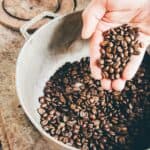10 Popular Café Drinks Explained

Picture the scene.
You’ve entered a bustling local Café, walked up to the counter and looked up above at the vast array of drinks on the menu. You think to yourself, “I just want a plain old coffee!”
With this in mind, I’m going to break down the anatomy of the 10 most popular Café drinks that are served all over the world. This is not an exhaustive list by any means, and of course the drinks you find in your local coffee shop will vary based on regional, cultural and national factors.
But, I hope this serves as a useful guide to help reduce that coffee shop anxiety!
Why Café Menus Can be Confusing
It doesn’t help that the menu you’ll find in most independent coffee shops doesn’t really explain what you’re ordering. Most people understand the difference between black and white coffees, frothy coffee and espresso.
But when you get into Italian based names like cappuccino and macchiato, things can get confusing.
Coffee drinks come in a range of different sizes, all with different iterations of steamed milk and froth.
Therefore, understanding the key differences between the most popular coffee drinks out there will help you walk into your local Café with confidence!
The 10 Most Popular Café Drinks Explained
Right, let’s get to it.
Here are the 10 most popular drinks you’ll find in most Cafés around the world.
This simple guide will break down the most popular coffee drinks, how they’re made and how you can easily spot them. You’ll never have that puzzled look on your face in your local Café again!
I’m going to explain the construction of each of these popular Café drinks, how they’re prepared and how you can easily recognize them below.
1. Espresso

First things first, let’s start with espresso.
The cornerstone of third wave coffee and the global Café scene, espresso forms the basis of most Café drinks. This rich, intense, concentrated shot of coffee tends to come in a 4oz double shot, unless otherwise specified.
Construction: A concentrated shot of coffee brewed by forcing hot water through finely-ground coffee beans under high pressure. The end result is a 4 oz shot of intense, concentrated coffee that is made from 1:2 coffee to water ratio.
Preparation: Very finely ground coffee beans are pressed using a tamper into a portafilter and inserted into the group head of the espresso machine. Hot water is then forced through the grounds at 9 bars of pressure. Thick, syrup-like coffee then drips out of the spout into the awaiting cup, in around 25-30 seconds.
How to Spot it: Espresso is typically served in a small demitasse cup, on top of an accompanying saucer with a teaspoon. It can be recognized by its rich, golden crema and intense, bold aromas. Espresso shots have a very bitter taste to them, due to the high level of total dissolved solids present in the cup. However, there is also a velvety texture and a lingering umami aftertaste.
2. Macchiato

Another Italian classic is the humble Macchiato.
Roughly translated as marked or stained, the macchiato is simply made using an espresso shot topped with a dollop of velvety milk foam.
This is a classic coffee drink served in Italy, which offers the combination of a short, sharp and intense shot of espresso, alongside the smooth, creamy, sweet steamed milk.
Construction: A typical shot of espresso is used to stain a small amount of steamed milk foam that sits on top.
Preparation: A shot of espresso is prepared as usual, but then topped with a dollop of frothed milk. The milk should be heavily aerated and pillowy or marshmallow-like in its texture.
How to Spot it: A Macchiato is distinguished by its layered appearance. There is a clear contrast between the dark, rich espresso on the bottom, and the white, pillowy frothed milk topping. It is still served in an espresso cup, but will have a white marshmallow-like appearance. You can expect a sudden hit of espresso intensity punching through the layer of soft milky froth.
3. Cortado

Moving away from Italian coffee classics, the Cortado is a short, sharp Spanish drink. The Cortado is famous for its combination of 1 part espresso to 1 part steamed milk, offering a delicious blend of flavours.
You can expect a delicious combination of intense, rich and earthy espresso, ‘cut’ with smooth, nutty and sweet steamed milk.
Construction: Equal parts espresso and steamed milk are used to make the Cortado.
This 1:1 ratio of intense coffee and creamy milk strike a great balance between two contrasting flavour profiles.
Preparation: A shot of espresso is pulled and added to a small glass tumbler. This is then combined with another 4oz helping of steamed milk with enough microfoam to be silky smooth. There is only a thin layer of froth on top of a Cortado, as it should have a smooth and homogenous texture. The result is a small, perfectly balanced and delicious cup of coffee.
How to Spot it: Cortados are typically served in a small glass, featuring a uniform coloration throughout. There is a very thin layer of microfoam on top that is often used to make latte art. The Cortado has a velvety smooth texture with a rich coffee flavour.
4. Flat White

Flat whites have become incredibly popular in recent years and are many people’s ‘go to’ order. It originated in Australia and combines silky smooth steamed with mellow, balanced espresso.
Aussies love a ‘flatty’ thanks to its creamy, sweet flavour and nutty undertones.
Construction: Flat whites are made using a double shot of espresso combined with velvety, micro foamed milk. It is combined using a 1:2 coffee to milk ratio, so is creamier than a cortado, but more intense than a latte.
Preparation: A double espresso is poured into a regular sized cup, followed by a layer of steamed milk and a thin layer of microfoam on top. The result is a smooth, homogeneous coffee drink that is creamy, nutty and delicious.
How to Spot it: Flat white’s are characterised by their creamy texture and velvety mouthfeel. They are typically served with intricate latte art patterns, so the baristas can show their skills.
5. Latte

The latte is one of the most iconic coffee drinks out there. With a rich history dating back centuries, the classic latte has taken many forms over the years.
At its heart is a creamy, smooth and delicious coffee drink that is a cornerstone of any Café’s menu. This milk drink takes smoothness to a new level, offering plenty of nutty, creamy and sweet flavours.
Construction: A double shot of espresso is topped plenty of steamed milk and a small amount of microfoam. Lattes are typically served in 6oz or 8oz cups, offering a creamy and indulgent coffee experience.
Preparation: The espresso is added to a large mug or glass and then homogeneously combined with a larger volume of steamed milk. This results in a smooth and milky beverage. A thin layer of microfoam is added to the top of the latte so a pleasing ‘latte art’ pattern can be poured by the barista.
How to Spot it: Lattes are served in a tall glass or cup. They have a creamy, light brown coloration due to the high milk content. They are often served with latte art patterns and have a coffee flavour compared to stronger espresso-based drinks.
6. Cappuccino

Another staple of the classic Italian coffee scene is of course, the Cappuccino. This frothy, creamy drink has a number of different variations, but is characterised by its thick layer of foam. Cappuccinos are often described as ‘dry’ compared to lattes for example, due to the heavy layer of foam not containing much liquid. The cappuccino is thought to have come from the Capscican Monks of the 1600s.
Construction: Generally, equal parts espresso, steamed milk, and milk froth are used to make a cappuccino. Many Cafés will make their cappuccinos using a higher volume of steamed milk, but nonetheless the result is a creamy and airy drink. Dark roasted coffee beans are often used to offset the thick layers of steamed milk and foam.
Preparation: A double espresso shot is added to a large, wide cup. It is then combined with equal parts steamed milk and frothed milk, which is usually poured at the same time but in separate layers. This results in a distinctively layered presentation with a thick layer of foam on top.
How to Spot it: The cappuccino can be recognised by its thick layer of frothed milk on top, and is often also topped with a dusting of cocoa powder. In terms of taste, it offers a bold espresso flavour with a light, airy texture.
7. Mocha

Thought to have hailed from the Mokka port of Yemen, the Mocha is a sweet coffee based drink that is typically served in Cafés. Combining sweet chocolate powder or syrup and bold, bitter espresso offers a delicious contrast in flavours. When combined with silky, smooth and nutty milk, you get a sweet treat that’s as close as you can get to dessert for breakfast!
Construction: Hot chocolate powder or sweet chocolate syrup is added to a double shot of espresso and swirled together until dissolved. This combination is then topped with steamed milk, offering a decadent and indulgent coffee experience. Chocolate powder can also be combined with the milk in a Café setting, which ensures homogenous, sweet steamed milk.
Preparation: Espresso and chocolate syrup or powder are combined in a tall glass or mug. After being swirled together, they are combined with steamed milk and topped with cocoa powder. The result is a delicious creamy beverage with a hint of sweetness.
How to Spot it: Mochas are characterised by its rich, chocolatey flavour and creamy texture, offset by the bitterness and boldness of the espresso. They have a dark brown colour and are often stopped with a light dusting of cocoa powder.
8. Hot Chocolate

Whilst not strictly a ‘coffee’ drink, hot chocolates are staples of the Café scene and are a great alternative to typical espresso beverages. Hot chocolates are a popular choice amongst Café goers that aren’t in the mood for coffee, simply don’t like it, or even for kids that shouldn’t be drinking it.
Construction: A mixture of steamed milk and chocolate syrup or cocoa powder are served in a tall glass or mug. This is often topped with whipped cream, cocoa powder, marshmallows and other sweet treats. Hot chocolates offer a comforting and indulgent alternative to typical espresso based Café drinks.
Preparation: Hot chocolate powder is added to cold milk in the pitcher and then steamed to combine. This sweet, chocolate steamed milk, which has the consistency of latte milk, is added to a tall glass or mug, up to just below the rim. It is then topped with cream and other sweet accompaniments to offer a decadent and delicious experience.
How to Spot it: The hot chocolate can be spotted a mile off thanks to its sweet toppings piled high above the mug or glass. It is characterised by its creamy texture and rich, chocolatey flavour. There’s no bitter or bold espresso to get in the way of the pure, rich sweetness here!
9. Filter Coffee

Filter coffee (otherwise known as batch brew) is known for its balanced flavour and relatively low price compared to most espresso based coffee drinks. Filter coffee is usually made in advance and served black, and offers a quick and easy alternative for those that want a more straightforward coffee experience.
Whilst filter coffee is often more mellow tasting than an Americano or long black, it actually tends to have a higher caffeine content due to its longer time stepping. So, if you want to keep things simple and desire a morning dose of energy, then give filter coffee a try.
Construction: Coffee brewed by dripping hot water over ground coffee beans contained in a filter, resulting in a clean and flavorful cup. The coffee is ground more coarsely than for espresso due to the longer brew time and less intense extraction. This also delivers a more mellow flavour profile.
Preparation: medium to coarse ground coffee is placed in a paper or metal filter and hot water is poured over it. This can be done in bulk or as a single serving, often via a V60 or Chemex. The coffee is then stirred and swirled and allowed to drip through the filter into a carafe or serving vessel below.
How to Spot it: Filter coffee is characterised by its clarity and brightness. The paper filter in particular offers a very smooth mouthfeel with little to no silt transferred into the cup. Filter coffee has a very well balanced flavour profile, and is typically served black unless stated otherwise, without any additional flavourings. Many Cafés will also offer different coffee beans held in a separate grinder for their filter coffee compared to espresso. This tends to be roasted slightly lighter.
10. Iced Coffee

Iced coffee adds a new dimension to popular Café drinks thanks to the contrast in flavours, temperature and serving style. Iced coffee is typically promoted heavily in the spring and summer months for obvious reasons. It is often combined with sweet syrups and offers a refreshing, thirst quenching alternative to iced tea.
Cold brew coffee is also sometimes served in Cafés, which is often steeped overnight. Iced coffee on the other hand combines a normal espresso shot with cold milk and ice, offering a brighter flavour profile.
Construction: Iced coffee is made using a double shot of espresso, which is then combined with large ice cubes and cold milk. This chilled coffee is often served with a straw and flavoured syrups are added for sweetness. Iced coffee offers a refreshing coffee beverage option, particularly during warmer months.
Preparation: A freshly brewed double shot of espresso is poured into a plastic, cardboard or glass cup and then topped with cold milk. It is often then served with a straw and is usually made to go.
How to Spot it: Iced coffee is characterised by its iced filled serving cups, which are often taken away rather than consumed in the Café. Iced coffee has a bold coffee flavour, which is then offset by sweet flavoured syrups.
Summary
Overall, Cafés can be confusing and overwhelming places, especially in the height of the rush when you aren’t quite sure what to order. I hope this guide can serve as a useful reminder for coffee lovers that want to enter a Café with confidence and know exactly what they want to order.
Now you can recognise the 10 most popular Café drinks, I’d encourage you to try and replicate your favourite at home!
Popular Cafe Drinks Frequently Asked Questions
The most popular coffee drinks served in cafes are: espresso, macchiato, cortado, flat white, cappuccino, latte, mocha, hot chocolate, filter coffee and iced coffee.
A latte is a creamier, larger and more homogenous drink compared to a cappuccino. The cappuccino is often topped with cocoa powder and is srrved in distinctive layers of espresso, steamed milk and thick froth.
Espresso is a thick, syrup-like concentrated shot of coffee, so is not exactly the same as a regular ‘cup of coffee’. Espresso is used as the base for many cafe drinks, as it is later dilluted down with steamed milk or hot water.



